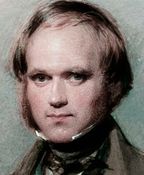 Charles Darwin was one of the most influential scientists of all time. He was the first person to clearly define evolution as selective breeding in which favorable variations in an organism are passed on, and unfavorable variations are dropped, so that the species on earth today have gradually evolved from common ancestors. He published his theory of evolution in a 1859 book, On the Origin of Species, and it wasn’t until one hundred years later that DNA studies provided scientific evidence to prove that he was correct.
Charles Darwin was one of the most influential scientists of all time. He was the first person to clearly define evolution as selective breeding in which favorable variations in an organism are passed on, and unfavorable variations are dropped, so that the species on earth today have gradually evolved from common ancestors. He published his theory of evolution in a 1859 book, On the Origin of Species, and it wasn’t until one hundred years later that DNA studies provided scientific evidence to prove that he was correct.
In 1837, at age 26 and a year after returning to England from a five-year voyage around the world, he became terrified to meet people because he would develop (in his own words), “a sensation of fear accompanied by troubled beating of the heart, sweat, trembling of muscles.” He no longer went to parties, began to withdraw from society, and spent his time entering notes in a journal to provide the most complete evidence of human evolution. He consulted many physicians who, at various times, incorrectly diagnosed him as having bad nerves, tropical disease, arsenic poisoning, intellectual exhaustion, dyspepsia, or “suppressed gout”. Today he would be diagnosed as having panic disorder, a condition that usually starts between late adolescence and the mid-thirties. This led him to his lifetime of working all the time sitting at his desk and not moving very much. Inactivity progressively weakens a person’s heart, and in 1882, at age 73, his sedentary lifestyle caused him to be diagnosed with heart pain that was called “angina pectoris,” followed by a heart attack, and he died in heart failure.
His Life Story
Darwin was born in 1809 into wealth and privilege, with a father who was a medical doctor and a grandfather who was a famous botanist. His mother died when he was eight years old. At age 16, he attended medical school at the University of Edinburgh and at age 18 went to Christ’s College in Cambridge. He then went on a five-year journey on the HMS Beagle, and collected many different birds, plants and fossils in the Pacific Islands, the Galapagos Archipelago and South America. On returning home, he developed his theory of evolution that today’s species had gradually evolved from common ancestors. In 1859, at age 49, he published his world-famous On the Origin of Species by Means of Natural Selection.
Personal Disregard for Genetics
Darwin married his first cousin, Emma Wedgwood, in 1839 and they had ten children. Two died in infancy, one died at age 10 of tuberculosis, and another died from scarlet fever, an infection with a strep bacteria. Three of the six surviving children had very long-term marriages but were unable to have children. Marrying a close relative increases risk for infections and infertility. Darwin’s family had intermarried for at least four generations (Bioscience, May 2, 2010;60(5):376-383). His mother and grandfather were from his wife’s family, the Wedgwoods, and his mother’s parents were third cousins. Darwin was arguably the world’s leading expert on inbreeding, having written three books that showed that plants suffer from inbreeding. However, he was able to pass on his genetic gifts as three of his sons were also brilliant and were knighted by Queen Victoria for their works.
Panic Disorder
In his early years, Darwin was gregarious, made lots of friends at school, was the life of every party in college, and was an active hiker and camper. After his voyage on the HMS Beagle, he spent his time sitting in a chair obsessed with his brilliant theory of evolution. Throughout his adult life, he was repeatedly sick in bed with stomach pains, vomiting, skin boils, heart palpitations, and shaking hands, particularly when he was stressed by social activities such as attending meetings or visiting people. He appeared to be driven by a panic disorder that manifests itself in unexpected attacks of extreme anxiety, with symptoms including rapid heartbeat, shortness of breath, trembling, sweating, nausea and dizziness. Some victims feel they are losing their minds or are about to die. Many become so obsessively worried about subsequent attacks that they make major changes in their behaviors, shunning whatever situations may have prompted the panic.
Treatment
Panic disorder affects an estimated 13 million North Americans. The most effective treatment appears to be talk therapy in which people learn to recognize and respond to factors that trigger their panic attacks.
• Drugs are prescribed to reduce suffering, but do not provide a cure. First choice and generally safe drugs are selective serotonin reuptake inhibitors (SSRIs) such as fluoxetine (Prozac), paroxetine (Paxil, Pexeva) or sertraline (Zoloft), and serotonin and norepinephrine reuptake inhibitors (SNRIs) such as Venlafaxine (Effexor XR) and Benzodiazepines. Central nervous system depressants such as alprazolam (Xanax) and clonazepam (Klonopin) are habit forming and should rarely be used as an early treatment.
• Support groups are often helpful.
• Avoid alcohol, smoking and recreational drugs.
• Check with your doctor about a supervised exercise program.
Disabilities Can Have Benefits
After a lifetime of working all the time, Darwin died at his home in London on April 19, 1882. Darwin might never have revolutionized biology with his theory of evolution if he had not suffered from chronic mental illness that turned him into a scholarly recluse.
When he died, he was buried at Westminster Abbey next to another genius, Isaac Newton. In 2018, Steven Hawking’s ashes were buried between the other two intellectual giants to form a triumvirate of three of the world’s greatest thinkers.
Charles Darwin
February 12, 1809 to April 19, 1882


